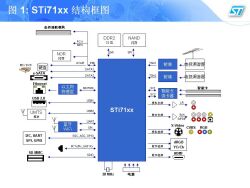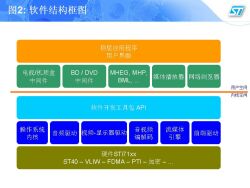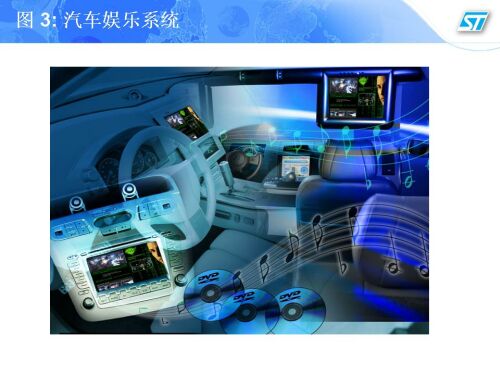Car rear seat entertainment system combining professional entertainment system for living room and mobile media source
Car rear seat entertainment system combining professional entertainment system for living room and mobile media source
For many years, it has been thought that the car rear seat entertainment system is a DVD player where passengers can watch movies and listen to music. Most car audio and video systems include a DVD drive and a display. The display may be installed with the drive or it may be installed separately in the rear seat area. With the continuous development of audio and video systems, infrared or Bluetooth wireless headphones are gradually popularized, and the codec standards supported by optical drives are also increasing, such as MP3 or DviX decoding standards. However, the data sources of these devices have not changed, and are still limited to DVD and CD media.
The next-generation rear-seat entertainment system must cover a wider range of data sources, provide stronger interactive support, and integrate more functions in the automotive infrastructure, which will not only increase the value of OEM original equipment, but also increase the equipment installed by dealers or The value of retail equipment.
But it is clear that price is one of the key factors for the market to accept the next-generation rear seat entertainment system now and in the future. Factors that affect the price include the overall cost of materials and hardware and software, which is mainly the cost of software development. This article mainly discusses how to reduce the overall cost of materials and the workload of software development.
A good first impression is the key to the product's widespread market acceptance, and the first impression has a great relationship with the ease of operation of the user interface. Obviously, if the user interface responds slowly or interrupts to user commands, even a very professional entertainment system will not be accepted by the market. Market leaders have proven that smooth and fast user interfaces are the key to product success. Adding 3D multi-window support can improve the overall ease of use of the system, but this requires additional image processing capabilities.
Next-generation rear seat entertainment system supporting more functions
In the future, what functions must the rear seat entertainment system support? Of course, DVD-Video must be supported for a long time, which can ensure that children are happy and happy on the way, and your existing disc library can be used for a long time. In addition to DVD-Video, Blu-ray will be the second disc standard supported by the system, because some movie discs may only use the Blu-ray standard in the future. Blu-ray not only has better audio and video performance, but also has improved security performance. Using the blacklist saved on the disc, Blu-ray can prohibit playing discs on "hacked" players. Increasing opportunities to experience interactive content (such as games) on Blu-ray players are strong evidence to support increasing market acceptance and a promotional tool.
In addition to optical discs carrying entertainment content, the new-generation entertainment system must also consider the function of playing movies from other storage media through USB or e-SATA interfaces, such as SD cards, U disks and mobile hard disks, which will inevitably encapsulate a large number of audio and video The format is introduced to the rear seat entertainment system. Therefore, the system must support a large number of file formats, including DivX, XviD, AVI, RealMedia, 3GP, ASV, MOV, OGM, etc.
The rear seat entertainment system must also consider live broadcast content such as TV broadcasts, the most important of which is the terrestrial TV broadcast system, such as DVB-T in Europe, ATSC in the United States, ISDB-T in Japan or DTMB in China. In addition, mobile TV standards must be considered, such as DVB-H in Europe, ATSC-M / H in the United States, T-DMB in South Korea, and CMMB in China. New TV standards that will soon appear, such as the mobile phone satellite TV broadcasting standard DVB-SH, which is similar to satellite radio broadcasting and is very popular in the United States. There will also be new live TV channels in the market, that is, broadcasting TV programs through the existing mobile phone infrastructure.
Our younger generation also needs interactive entertainment content. Internet-connected data lines allow them to use various services, such as YouTube, Twitter, Facebook, and many other social networking sites. On this issue, it is clear that the entertainment system architecture also needs to accept a web browser and support common plug-ins. Only in this way can we provide users with more entertainment services, such as Internet radio and Internet TV, and provide users with as many types of entertainment content as possible. Also, why not add the home media streaming engine access function, so that users can remotely access the content recorded at home? This can save the transmission or synchronization of media content between home and car. Of course, these services need to be at least similar to EDGE or HSDPA data transmission services, and access service providers should provide a monthly or annual charging strategy. Once popularized, the existing infrastructure will need to be improved or replaced by the fourth-generation mobile communication LTE.
In short, the rear seat entertainment system is a combination of a professional entertainment system in the room and a mobile media source-a mobile room. The rear-seat entertainment system needs to support commonly used robust functional features, as well as the flexibility and enhanced features to upgrade to the latest features.
How to reduce development costs?
How can the hardware overcome the challenges of so many features of the entertainment system while keeping development costs low? Obviously, the solution to this problem is to reuse the existing platform architecture outside of the consumer electronics industry to provide high-end media playback support and various external interfaces. Huge price pressures force manufacturers to provide cost-effective solutions that are consistent with the commonly used features proven in the market.
ST's entertainment-specific product series STI71xx supports high-definition decoding (1080i / p) and multi-channel audio decoding and post-processing. The main application program runs on the ST40 processor compatible with the SH4 CPU. The main task of this CPU is to run customer-specific programs to control audio and video signal processing. All audio and video decoding tasks are transferred from the main CPU to two very long instruction word (VLIW) processors. One of the processors is responsible for audio processing, and the other is responsible for video decoding. This method of processing audio and video separately from the CPU application helps reduce the complexity of the system and enhance the overall robustness of the entire system. During the processing of corrupted data, if an error occurs, the audio and video processor can be easily reset. Using firmware on two VLW processors increases the flexibility of the firmware. According to the codec request, the processor can load one or more firmwares to support video encoding standards (such as H.264, MPEG-2, VC-1 or AVS) and audio encoding standards (such as MPEG-2, MP3, WMA, AAC, Dolby, DTS, OggVorbis) and other file formats. In addition, the audio processor performs post-processing functions such as audio signal mixing, sample rate conversion, stereo multi-channel to two-channel down-mix, and surround sound. By loading the processor with new firmware, you can upgrade the codec. Before loading, make sure that the processor supports the new or improved codec standard. Firmware is developed and provided by chip manufacturers, so application developers do not have to worry about firmware development and maintenance. Moreover, the driver ensures that the firmware is correctly integrated into the main application. Because the flexibility of the firmware is very high, the decoder can also be used for audio and video encoding and encoding conversion, changing the format and / or transmission rate of the existing code stream. The application memory is a 32-bit DDR2 memory, and the three CPUs can directly access the memory, which can ensure that the processor that consumes bandwidth has priority access to the memory.

In addition to multiple CPUs, the 71xx series system chips also provide video output stage, audio output stage and peripheral interfaces. The video output stage provides analog and digital video output. According to the system architecture, you can choose CVBS, Y / C, RGB for analog connection, or choose digital RGB, YCrCb or HDMI to establish digital connection. The 71xx series supports two independent video signal outputs and can drive two rear-seat displays (left and right displays) with one decoder. The audio output supports multi-channel digital I2S output including parallel stereo mixing signals. In parallel stereo, an on-chip digital-to-analog converter provides stereo analog signals compatible with headphone jacks, so no external digital-to-analog converter is required. Through a car audio network such as MOST, digital audio signals can be transmitted to a remote audio amplifier. In addition, this series of products also provides a multi-channel output with S / PDIF function. All STI71xx series products are equipped with a digital audio and video input, allowing the rear seat entertainment system to be connected to other audio-visual equipment, such as digital video cameras.
The system chip concept can provide many of the most commonly used peripheral interfaces. Some products of the STI71xx series provide two USB 2.0 ports embedded in the physical layer chip. These two ports can be connected to a USB flash drive, a mobile hard disk, and a UMTS / HSDPA wireless network card. If you need more on-chip host ports, you can use the on-board hub to expand the number of USB ports.
To connect the internal hard drive and optical drive such as Blu-ray or DVD, the STI71xx series provides two SATA interfaces. In order to connect external SATA devices, these interfaces also support the e-SATA standard. To connect the old DVD drive, the EMI port also provides the traditional ATAPI parallel port, which is a 16-bit data bus.
There are many ways to access the Internet in a car. You can hang a UMTS / HSDPA wireless network card on the USB interface, or connect the existing communication equipment in the car through Ethernet. Ethernet cables can be wires or optical cables, depending on the car's existing infrastructure. The external UMTS / HSDPA wireless network card avoids the problem of verifying the entire system in every country or region. If the end user connects to a USB wireless network card, he needs to handle the network compatibility and service provider's contract by himself. It is very easy to achieve Bluetooth and WiFi connection, as long as you add a two-in-one device that supports one of the formats or both formats. The SDIO interface allows the entertainment system to add an SD or MMC card reader. For example, users can view photos in a digital camera and expand the memory capacity used to record TV programs. The on-chip infrared transceiver supports Remote Control function. In addition, the chip is also equipped with peripheral interfaces such as I2C, SPI, UART, GPIO.
In terms of digital TV support, STi71xx series products provide up to three stream input channels, one or two of which are used for real-time playback decoding, and the third is used for background TV recording, channel scanning or data services. Compared with home set-top boxes, car TVs need to be prepared to adjust the frequency, because the car is mostly in a moving state. To be able to handle encrypted content, the STi71xx series has an on-chip encryption core that can decrypt major copy protection formats, such as TV recording protection, DVD-Video, Blu-ray, and streaming media copy protection. The keys required for the decryption process can be accessed through two intelligent interfaces. Alternatively, a conditional access module can be connected to the chip to provide the system with the flexibility to connect a local encryption module. A NAND flash memory can be used to store applications and media files or TV recordings for time-shift viewing. The flash memory can replace the internal hard drive without solving data access problems during car bumps.
Only a 30 MHz oscillator is required to run STi71xx series products. This series of products has an on-chip frequency synthesizer and voltage-controlled crystal oscillator, which can independently generate audio and video decoding clocks and system clocks. For example, this can be synchronized with the broadcaster's clock. Compared with other solutions that require multiple clock sources, an oscillator can reduce material costs.
The power supply must provide four voltages: a core voltage of 1.2V, a DDR2 memory voltage of 1.8V, and a peripheral interface voltage of 2.5V and 3.3V. The average power consumption is about 2W, which is related to the application being executed. The next generation of products mainly focuses on reducing power consumption. Driven by the "green" concept and the mobility of media processors, next-generation products must not only reduce operating power consumption, but also reduce standby power consumption.
This is a brief introduction to the STi71xx series of products from the level of technical functions. Some technical functions can meet the automotive-grade quality standards for OEM applications. If necessary, we can provide more detailed product and system information.

On the software side, software is another aspect that solves the problem of how to drive down development costs. It is not cost-effective to develop a multimedia software stack from scratch. The proliferation of codecs and packaging formats has greatly increased the cost of software development. On this issue, by providing software stacks for system chips, chip providers give equipment manufacturers a lot of development support. The software stack integrates the most commonly used audio and video codec software mentioned above. The driver interface provides a well-known API interface for system integrators. Unlike the driver software stack that focuses on all hardware-specific projects, the elements for system development are: operating system. The market's strong demand for enhanced media decoding features and online access applications requires the use of an existing application library that can provide most of the application software. These software modules are called middleware, and the providers are software companies or open source communities that integrate intellectual property in the middleware.
Compared with the rear seat entertainment system with only one DVD, the choice of operating system becomes more and more difficult. Proprietary operating systems have advantages in code size and efficiency, but require a lot of hardware driver and application software development work. If you use an operating system that everyone is familiar with, such as WinCE or Linux, there are a variety of applications and driver software available. Because the driver software is hardware-specific, chip manufacturers must provide drivers in the software development kit. The development kit contains all the components needed to run the application: the operating system, drivers, and codec software. Some open source application software like WebKit browser or media player may be placed in the package in order to speed up application development. These applications depend on the existence of the video API. For example, in the Linux platform, there must be V4L (Linux video) or ALSA (Advanced Linux Audio Architecture). Other middleware like DVD-Video or Blu-ray playback engine, MHEG, MHP, BML or Java components can run and be easily implemented on the video API, this process has nothing to do with the hardware used. Finally, the top-level application that runs the user interface will be the framework of the entire system, and system developers can invest tremendous energy in the framework to make it more unique than the competitive system. The on-chip graphics kernel allows developers to create a simple and easy-to-use interactive user interface.

From playing CD and external storage content, to live TV decoding and network media streaming, the next-generation rear seat entertainment system will provide a wealth of functions. As the end user's standard increases, the video format supported by the system will be expanded from QCIF / QVGA to the high-definition standard. Effective use of existing systems, including hardware and software, is an element to speed up the development cycle and control the development workload. The development of a large number of audio and video codes requires long-term and proven consumer electronics device development experience.
Our company is specialized in supplying Welding Torch . Quick self-lighting,Brazes/Solders,Swirl Flame,variable flame control,Tip swivels 360 degree. Generates more heat than other hand torches. Faster brazing times and less gas consumption. Long life life. 4 interlocking safety button,reliable to use,comfortable handling. Designed for Propane or MAPP.CGA600 connections .Adjustable pressure .Use with MAPP or PROPANE TANKSTypical ApplicationsUsed for Copper/ Brass Tubes Welding/Brazing.Used for Copper/ Brass Fittings or Welding/Brazing.Valve Body made of Brass.For use with 14.1-16 OZ Containers.HVAC After Market
Welding Torch
Welding Torch,Welding Machine,Mapp Gas Torch,Gas Welding Torch
ZHEJIANG ICE LOONG ENVIRONMENTAL SCI-TECH CO.,LTD. , https://www.ice-loong.com